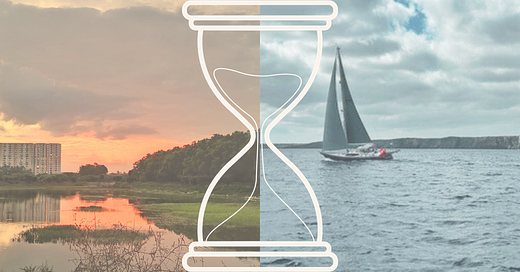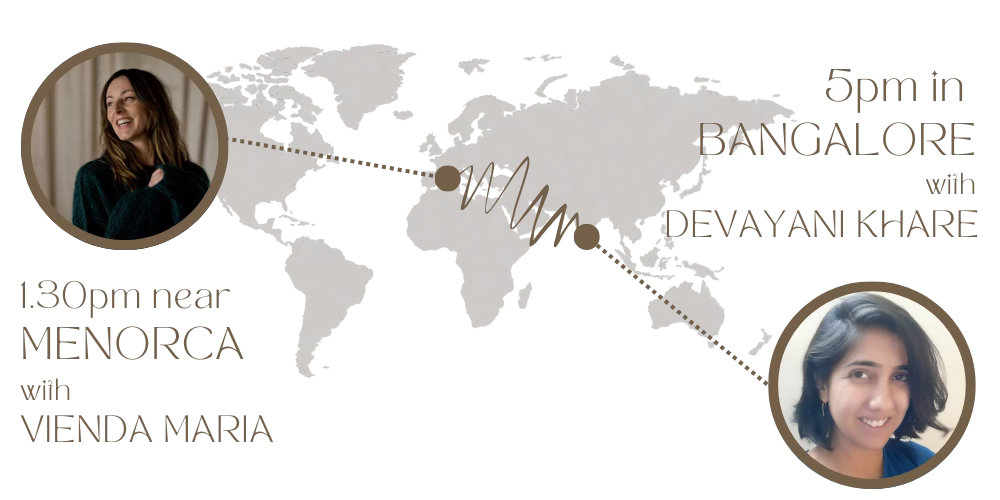5 o'Clock Somewhere #2
Two countries, two writers, one shared moment. This edition: India and the Mediterranean.
Dear NE-One
About two weeks ago I sent you the first installment of 5 o’Clock Somewhere, a project I’ve set up with writers around the world. From the comments and feedback I’ve received, it seems you enjoyed reading it as much as we’ve enjoyed working on it - and I’ve been looking forward to sharing this second installment with you.
In case you missed the last one, here’s what 5 o’Clock Somewhere is all about:
The juxtaposition of place and time fascinates me – so I connected with women around the world and invited them to take part in a project I’ve called 5 o’Clock Somewhere. At exactly the same time, pairs of writers in vastly different places sit down to record the world around them – and what’s emerged is something truly beautiful.
This week we have an evocative essay by geographer and ecologist Devayani Khare, who recorded 5pm near Bangalore, and the second is by Vienda Maria who, at that exact time, was sailing in the Mediterranean somewhere between Menorca and Mellorca.
The women were separated by 7,680km, but connected through time; here is how the moment they shared unfolded:
5pm – Harohalli Lake, Bangalore (India)
with Devayani Khare
A hot, sweltering day ends on a cloudy note; the blanket of grey heralds an early twilight. I’m at Harohalli Lake on the northern fringes of bustling Bangalore in South India. This is one of the few refuges from the city’s clamour and chaos, and the sounds from the nearby highway and the railway track that skirts the lake provide an occasional chord to wilder symphonies.
In the eastern sky, a whip of lightning and the distant rumble of thunder set the stage for the evening concerto. The strident notes of a grey francolin; crickets chirping in the undergrowth; a flutter of shrill parakeets overhead; fluted notes from the white-browed wagtails and a pair of whistling ducks; the throaty cries of a swamp hen; the gurgling sounds of herons; the loud, insistent paaon-paaon of peafowls; these are the usual chorists in the lakeside fugue.
Numerous denizens are not part of the choir, yet their movements add to the visual symphony at the lake. Overhead, black kites wheel and circle, making the most of the last thermals. Along the water’s edge, a restless fleet of dragonflies hover and hunt; a zigzag ripple is the only sign of the Asiatic water snake, swimming through the reeds. The darter hunts in deeper waters, its pointed beak occasionally breaking the surface before it plunges in again. In the shallows, cormorants perch on driftwood and spread their wings to dry off.
On the western horizon, ranks of cumulus clouds assemble to thunderous drumroll. The sun’s honeydew rays spill out from the last tatters of blue sky. The surface of the lake, often dimpled by the light touch of the wind, reflects the dense foliage around: the fresh hues of bamboo thickets that sprout on the islets, the dark reeds and rushes that grow in the shallows; the olive-green train of the eucalyptus and the crescent-shaped acacia that line the dusty track around the lake.
I walk along its periphery and take in the subtle, often imperceptible smellscape: the medicinal notes of eucalyptus, a dank smell where the reeds thrive. There’s the rancid scent of a cobra’s nest, a smoky trace near the residential areas – perhaps a residue of burnt garbage – and the lightest whiff of petrichor.
As dusk approaches, orb-weaving spiders craft near-invisible webs in the undergrowth, and the long-legged lynx spiders assume positions on the tips of branches. As ambush predators, they will sit and wait for their prey to approach before they overpower and paralyse it. Along the periphery, ants scurry between tiny, sandy steeples; their labours will continue long into the night.
Over the past two years, I’ve spent countless sunsets at this lake. In these moments, I’m reminded of Henry David Thoreau’s words, “A lake is a landscape's most beautiful and expressive feature. It is Earth’s eye; looking into which the beholder measures the depth of his own nature.” And so, I sit by the lakeside and watch the rhythms and rituals of those who call it home as I reflect on the ebbs and flows of my life.
Devayani Khare is a geographer and ecologist who is fascinated by landscapes. In her Geosophy newsletter she writes about deep-time memories etched in natural and cultural landscapes, and explores the intricate connections between the physical environment, biodiversity and human history.
1.30pm – somewhere near Menorca (Spain)
– with Vienda Maria
It's 1:32 pm, and I'm gently heating leftover pasta carbonara on the gas stove inside our 46-lagoon catamaran. The rich aroma of earthy pancetta and aged parmesan wafts through the galley, intertwining with the briny scent of the Mediterranean Sea. As I stir the pasta, the soft clink of the wooden spoon against the pan mingles with the rhythmic lapping of waves against the hull.
Our vessel glides smoothly through the water, leaving a gentle wake as we make our way from a secluded bay to Port Mahon on the Balearic Island of Menorca. The overcast sky casts a silvery light across the water, transforming the usually vibrant turquoise Mediterranean into a palette of muted greys and blues. It's a stark contrast to yesterday's brilliance when the early autumn sun painted the sea in dazzling hues.
The cooler temperature today brings a refreshing crispness to the air. I can feel the slight chill on my skin as I step out of the galley onto the deck, my bare feet padding softly on the smooth surface. The breeze carries a hint of dampness, a whisper of potential rain.
The absence of wind means our sails remain furled, leaving an unobstructed view of the horizon where sea meets sky in a hazy, indistinct line. The engine's steady hum provides a constant backdrop to our journey, its vibrations felt through the deck beneath my feet. It's a reminder of our reliance on technology even as we surrender ourselves to the whims of nature.
As I return to the kitchen, I'm struck by the profound silence that envelops us. Save for the water sloshing against the edges of the boat and the engine's persistent purr, human-made sounds are absent. No traffic, no chatter, no background hum of civilization. It's a silence that feels alive, teeming with the subtle sounds of the sea and our passage through it.
The need to return to port for a stable WiFi connection and to restock provisions serves as a gentle tether to the world we've temporarily left behind. It's a reminder of the delicate balance we strike between our seafaring life and the demands of the modern world. Client calls and grocery lists seem almost incongruous with the timeless rhythm of life at sea, yet they're an integral part of this unique lifestyle.
Being out here has recalibrated my sense of time and priorities. Here, the elements dictate our schedule. Every decision – from our destination to our sleeping arrangements, our departure time to our course – is made in harmony with the natural world around us.
This surrender to nature brings an indescribable peace. There's nowhere to rush to, no way to outpace myself or my thoughts. The constant motion of the sea, the ever-changing sky, and the vast expanse of water stretching to the horizon create a moving meditation. It's a space where introspection comes naturally, where the boundaries between self and environment seem to blur.
As I settle into a comfortable spot to enjoy my meal, I feel a profound sense of contentment. The catamaran continues its steady progress towards Port Mahon, but in this moment, I'm exactly where I want to be – present with myself, surrounded by the gentle embrace of the sea, and perfectly attuned to the rhythm of this floating home. The anticipation of future adventures to Sardinia adds a subtle excitement to the air, but for now, I'm fully immersed in the beauty and simplicity of this moment, grateful for the peace and perspective that life at sea provides.
Vienda Maria is a psychology-informed women’s personal-growth educator. Her Substack, Kismet, is a space where she explores the art of intentional living, and she takes readers on heart-opening journeys of discovery.
5 o’Clock Somewhere is a project to which the writers have volunteered their time, and I really am so grateful to Devayani and Vienda for being a part of this, and for so generously opening a window into their world.
Other women have taken part in this project, and I have more essays to share with you in the coming weeks. Also, as I’m no longer walking a trail in Spain (I reached Santiago two days ago) I’m now back to regular programming here on NE Where and have loads of stories to share with you in the coming weeks.
Until next time,
Narina x










I enjoyed these lyrical meditations on how much these women centred the natural environment into their lives.
I love the idea!🥳
Happy to connect with someone too